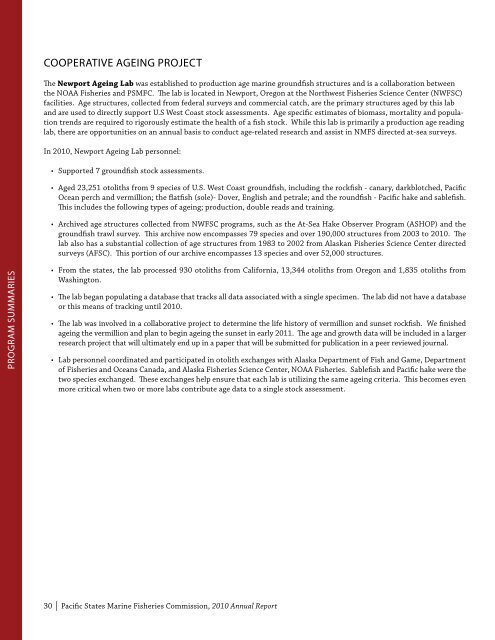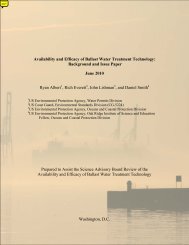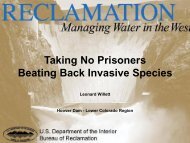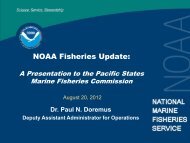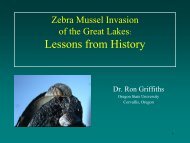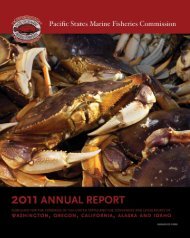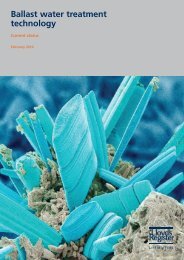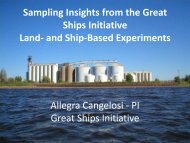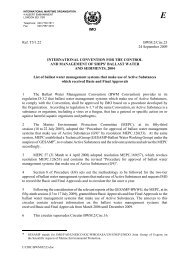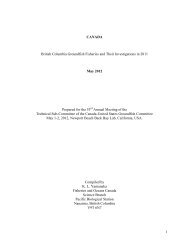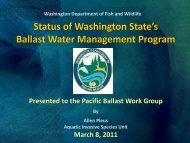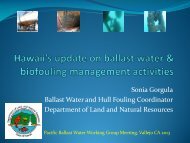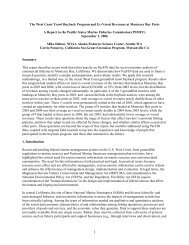2010 PSMFC Annual Report - Pacific States Marine Fisheries ...
2010 PSMFC Annual Report - Pacific States Marine Fisheries ...
2010 PSMFC Annual Report - Pacific States Marine Fisheries ...
You also want an ePaper? Increase the reach of your titles
YUMPU automatically turns print PDFs into web optimized ePapers that Google loves.
Cooperative Ageing Project<br />
The Newport Ageing Lab was established to production age marine groundfish structures and is a collaboration between<br />
the NOAA <strong>Fisheries</strong> and <strong>PSMFC</strong>. The lab is located in Newport, Oregon at the Northwest <strong>Fisheries</strong> Science Center (NWFSC)<br />
facilities. Age structures, collected from federal surveys and commercial catch, are the primary structures aged by this lab<br />
and are used to directly support U.S West Coast stock assessments. Age specific estimates of biomass, mortality and population<br />
trends are required to rigorously estimate the health of a fish stock. While this lab is primarily a production age reading<br />
lab, there are opportunities on an annual basis to conduct age-related research and assist in NMFS directed at-sea surveys.<br />
In <strong>2010</strong>, Newport Ageing Lab personnel:<br />
• Supported 7 groundfish stock assessments.<br />
• Aged 23,251 otoliths from 9 species of U.S. West Coast groundfish, including the rockfish - canary, darkblotched, <strong>Pacific</strong><br />
Ocean perch and vermillion; the flatfish (sole)- Dover, English and petrale; and the roundfish - <strong>Pacific</strong> hake and sablefish.<br />
This includes the following types of ageing; production, double reads and training.<br />
• Archived age structures collected from NWFSC programs, such as the At-Sea Hake Observer Program (ASHOP) and the<br />
groundfish trawl survey. This archive now encompasses 79 species and over 190,000 structures from 2003 to <strong>2010</strong>. The<br />
lab also has a substantial collection of age structures from 1983 to 2002 from Alaskan <strong>Fisheries</strong> Science Center directed<br />
surveys (AFSC). This portion of our archive encompasses 13 species and over 52,000 structures.<br />
program summaries<br />
• From the states, the lab processed 930 otoliths from California, 13,344 otoliths from Oregon and 1,835 otoliths from<br />
Washington.<br />
• The lab began populating a database that tracks all data associated with a single specimen. The lab did not have a database<br />
or this means of tracking until <strong>2010</strong>.<br />
• The lab was involved in a collaborative project to determine the life history of vermillion and sunset rockfish. We finished<br />
ageing the vermillion and plan to begin ageing the sunset in early 2011. The age and growth data will be included in a larger<br />
research project that will ultimately end up in a paper that will be submitted for publication in a peer reviewed journal.<br />
• Lab personnel coordinated and participated in otolith exchanges with Alaska Department of Fish and Game, Department<br />
of <strong>Fisheries</strong> and Oceans Canada, and Alaska <strong>Fisheries</strong> Science Center, NOAA <strong>Fisheries</strong>. Sablefish and <strong>Pacific</strong> hake were the<br />
two species exchanged. These exchanges help ensure that each lab is utilizing the same ageing criteria. This becomes even<br />
more critical when two or more labs contribute age data to a single stock assessment.<br />
30 | <strong>Pacific</strong> <strong>States</strong> <strong>Marine</strong> <strong>Fisheries</strong> Commission, <strong>2010</strong> <strong>Annual</strong> <strong>Report</strong>


